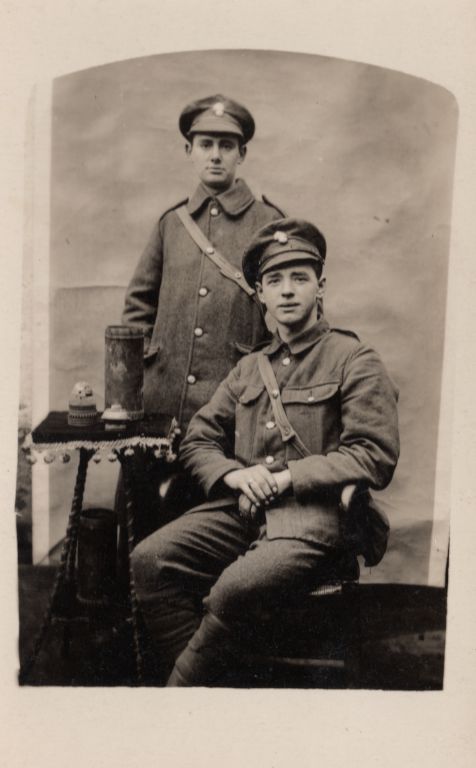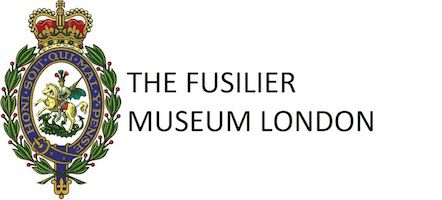The following extract abridged from Albert Clayton’s recently discovered WW1 memoir Long Before Daybreak provides a spine-tingling revelation about one of the photos found with the book. The Company had just returned from the front line to their billets in Arras.
Blackall, suddenly turning to me, remarked inconsequently, “Come and ‘ave yer photo took with me tomorrow, will you, Clayton? I have found a place this afternoon where they do it cheap. Six postcards for five francs. You come in with me young ‘un and we’ll ‘ave three apiece for f.2.50.”
I agreed to share the six postcards with Blackall, so on the following day when the mud on my boots and puttees had had time to dry and been scraped off, we set out to find the photographer Blackall had discovered.
 In a narrow side street just off the Rue de Gambetta we found him; a short, elderly Frenchman, too old and stout for active service. One wondered why he chose to stay behind in such an unsafe place as Arras. It hardly seemed possible that the few miserable francs he made out of the troops could be sufficient compensation for the lack of safety and civilised comforts.
In a narrow side street just off the Rue de Gambetta we found him; a short, elderly Frenchman, too old and stout for active service. One wondered why he chose to stay behind in such an unsafe place as Arras. It hardly seemed possible that the few miserable francs he made out of the troops could be sufficient compensation for the lack of safety and civilised comforts.
Dressed in a shop-worker’s seedy frock-coat, he welcomed us with a quick little bow, polite but business-like. He motioned us forward with a fat little hand outstretched, into the bare dusty studio, lit uncertainly from above by means of a cracked skylight.
Against one wall a crinkled backcloth hung like an old roller-blind. In front of this stood one of those rickety bamboo tables and there reposed in burnished glory on a purple velvet cloth one large shell-case and two nose caps, while on the shelf underneath, a larger and heavier “dud” shell completed the collection and served to steady the table.
Blackall, the finicky dresser, had taken care to ‘posh himself up’ before we came. Brushed his tunic, polished his buttons and badges, and wound on his puttees carefully in even spirals.
We had left our tin hats at home as not being smart enough for the occasion, and as we waited there set stiffly in the photographer’s conventional pose while he dived under the black cloth and focused the camera, Blackall carefully tilted his forage cap to the right doggish angle.  With everything set he held up an admonishing finger and rapped out, “attention pleese!”
With everything set he held up an admonishing finger and rapped out, “attention pleese!”
Silence, while we gazed unblinkingly at the lens.
With a quick little professional bow and a resounding “voila, messieurs! C’est fini” the little man indicated that the business was over.
“Demain matin à dix heures, mais maintenant cinc francs s’il vous plaît M’sieurs” holding out his podgy hand and rubbing finger and thumb together as if counting notes.
“What he say?” demanded Blackall.
“They’ll be ready tomorrow at ten, but he wants the dough now” I explained.
“Oh! The hell ‘e does,” bridling a little at the idea of paying in advance, “Don’t trust us far, do ‘e?”
The little man sensed a difficulty and explained that we might be killed by a shell in the night or leave suddenly for the trenches and never return, in which case his work would be wasted.
“Well, for that matter a shell might fall on his shop in the night, then we’d lose both photos and five francs as well. Ten francs in all” argued Blackall.
We paid up however, and promised to call for the six postcards on the morrow. Which we did, and found them all ready for us.
I sent my three postcards straight home and as I write they lie before me, but whether Blackall ever lived to see any of his three again, or whether he died in one of the many adventures which later befell the Battalion, I shall probably never know.
Long Before Daybreak by Albert Clayton is published in paperback and eBook on Amazon.
Further information at www.longbeforedaybreak.com
Further extracts from the book will be published on our BLOG in the coming weeks.
